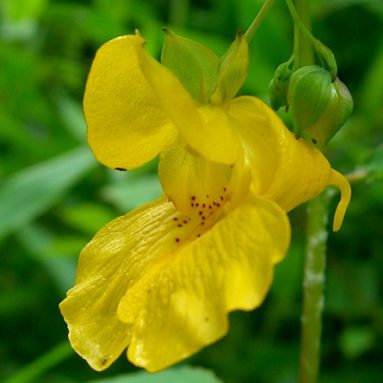Flower family knows its roots
Impatiens wildflowers seem to know who's sharing their soil
 |
|
Yellow jewelweeds, wildflowers that grow along shady watersides in eastern North America, apparently can recognize their siblings as long as roots share soil. |
| pellaea/Flickr |
Jewelweeds, or Impatiens, are pretty flowers that grow in wet, shady spots all over the Northern Hemisphere. According to a recent experiment, they seem to know their own flower family.
The experiment suggests that these flowers can recognize each other—or at least, recognize whether or not they came from the same mother plant. Together with other experiments, these results show that if the plants are recognizing their kin, it’s not through their leaves, it’s through the roots.
Guillermo P. Murphy and Susan Dudley are a pair of botanists, or scientists who study plants, from McMaster University in Hamilton, Canada. In this experiment, they planted jewelweeds in pots with either siblings or strangers. Sibling plants were grown from seeds that came from the same mother plant. Stranger plantswere grown from seeds from different plants.
If people were plants, then this experiment would be like showing that a person behaves differently if he grows up next to his brother than if he grows up next to a stranger.
When jewelweeds were planted in pots with strangers, the plants started to grow more leaves than if they had been planted alone. This response suggests that plants are competing with strangers for sunlight, since a plant with more leaves can receive more light—and make more food. Impatiens normally grow in the shade, where sunlight is scarce.
 |
|
Researchers grow jewelweed seedlings in tall pots to test for effects of growing near siblings or non-siblings. Plants react mildly to siblings but start shifting their resources to leaf warfare when surrounded by strangers, researchers found. |
| G. Murphy |
When jewelweed seedlings were planted with siblings, they grew a few more branches than they normally would if they were alone — but they did not start growing lots of extra leaves. This behavior suggests the plants are more likely to share resources, rather than compete.
The plants only responded this way when they shared soil. If stranger seedlings were planted in different pots and placed next to each other, for example, they did not grow more leaves. This difference shows that the plants must use their roots to detect sibling plants in the same soil.
“This is the first paper that shows that plants are responding above ground to sibling roots,” Murphy told Science News.
Impatiens plants are not the first plants that botanists have studied for family recognition. In 2007, Dudley and her team studied the Great Lakes sea rocket, a plant that grows on the beach—where it may be hard to get fresh water. In that experiment, the botanists observed that when sea rockets were planted with siblings, they tolerated each other. But when they were planted with strangers, the sea rockets reacted by working extra hard to grow lots of roots, but not extra leaves. Dudley says this behavior makes sense because sea rockets, on the beach, get plenty of sun but struggle for water—so when they’re threatened, they compete for water. Impatiens, on the other hand, have plenty of water but have to compete for sunshine.
The different types of plants may react in different ways, but they have one thing in common: the roots. In both experiments, on Impatiens and sea rockets, the key was the shared soil—and other plant species may turn out to show similar behavior. These experiments, as well as earlier experiments, suggest “the phenomenon is quite common,” says Hans de Kroonof, an ecologist in the Netherlands.
POWER WORDS (from the Yahoo! Kids Dictionary)
seedling A young plant that is grown from a seed
botany The science or study of plants
ecology The science of the relationships between organisms and their environments
impatiens Any of various plants of the genus Impatiens, which includes the jewelweed.
Going Deeper:







